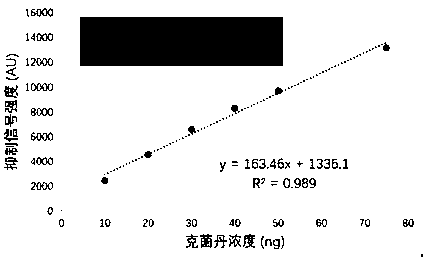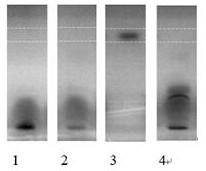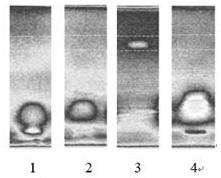Method for quickly and quantitatively screening captan residue in fruit through high-performance thin-layer chromatography coupled with photobacterium phosphoreum biosensing
A technology of bright photobacteria and high-performance thin-layer chromatography, which is applied in the determination/inspection of microorganisms, chemiluminescence/bioluminescence, biochemical equipment and methods, etc., can solve captan decomposition, difficult captan accurate analysis, false Negative results etc.
- Summary
- Abstract
- Description
- Claims
- Application Information
AI Technical Summary
Problems solved by technology
Method used
Image
Examples
Embodiment 1
[0025] (1) Preparation of captan standard solution: use ethyl acetate as a solvent to prepare a standard solution of captan with a concentration of 0.01 mg / mL, and then to establish a standard curve, the standard solution needs to be diluted to 0.001 and 0.0005 mg / mL ;
[0026] (2) High-efficiency thin-layer chromatography separation: 4-8μL captan standard, apple, pear and cherry samples were accurately spotted with Linomat 5, and after spotting was completed, a developing solution (toluene: ethyl acetate = 8: 2 (v / v)) unfolding, the upward unfolding distance is 60 mm, after the unfolding is completed, take out the silica gel plate and place it on a flat heater at 100°C for 5 minutes to fully dry;
[0027] (3) Imaging with a bioluminescence imager: the high-performance thin-layer chromatography plate in step (2) is dipped to couple the suspension of Bright Bacteria with the chromatographic separation results, and then placed in a bioluminescence imager for imaging;
[0028] (...
Embodiment 2
[0031] The specific implementation method is the same as in Example 1, the difference is that the selection of the mobile phase for development, the test toluene:ethyl acetate=8:2 (v / v) has the best development effect, and then the matrix effect experiment is carried out with the same ratio of mobile phase. There is no obvious difference in the development effect, indicating that the sample matrix has no obvious interference on the development, and this mobile phase is used for the development of the recovery of the standard addition.
Embodiment 3
[0033] (1) Apples, pears and cherries and different spiked quantities were tested separately.
[0034] For the pretreatment of fruits: apples, pears and cherries: add 10 g of fruit sample homogenate to a 50 mL centrifuge tube, continue to add 10 mL of acetonitrile, 0.1 mL of formic acid, shake and mix, ultrasonic water bath for 10 min; then add 4 g Anhydrous magnesium sulfate and 1 g of anhydrous sodium acetate, shake and mix well, centrifuge at 4000r / min for 5 min, take 2-4 mL of the upper acetonitrile phase, and pass through a 0.45 μm filter membrane to obtain a liquid sample that can be directly used for analysis. Refrigerate it at 4°C.
[0035] Pretreatment of the sample solution of the recovery rate of the standard addition: add 10 g of the homogenate of the fruit sample into a 50 mL centrifuge tube, continue to add 10 mL of acetonitrile, 0.1 mL of formic acid, oscillate and mix, and ultrasonically bathe for 10 min; then add 4 g of anhydrous magnesium sulfate and 1 g of ...
PUM
 Login to View More
Login to View More Abstract
Description
Claims
Application Information
 Login to View More
Login to View More - R&D
- Intellectual Property
- Life Sciences
- Materials
- Tech Scout
- Unparalleled Data Quality
- Higher Quality Content
- 60% Fewer Hallucinations
Browse by: Latest US Patents, China's latest patents, Technical Efficacy Thesaurus, Application Domain, Technology Topic, Popular Technical Reports.
© 2025 PatSnap. All rights reserved.Legal|Privacy policy|Modern Slavery Act Transparency Statement|Sitemap|About US| Contact US: help@patsnap.com



